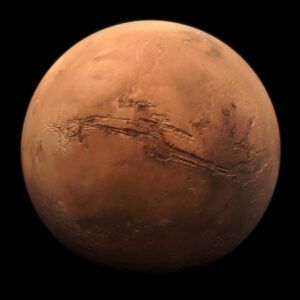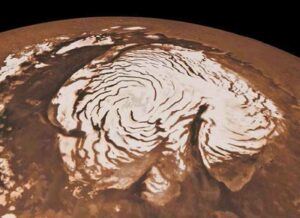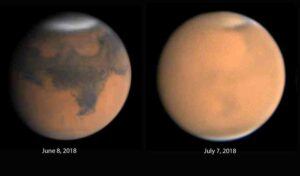*This post may contain affiliate links. This means we may make a commission if you purchase an item using one of our links*
If you want to learn how you can view Mars through a telescope, this article is a great place to start. Within not only will we be breaking down how to see Mars with a telescope but also how to locate the planet, the equipment necessary to view it and what’s worth checking out once you’ve sorted out all of the basics.
In short, if you want to see Mars you will ideally want to locate it using Stellarium, a telescope that can magnify at least 40x – 50x and view it in its brightest period, which for 2020 is October 4th – October 17th. On top of that if you want to observe the surface details on Mars, a telescope that can magnify in the 300x range would be ideal among other optional equipment.
Of course within the rest of this article all the equipment requirements, how to find the location and other relevant elements will be broken down in more detail but, as a simple breakdown of how you should go about observing the planet, the above statement should at least guide you in the right direction.
What Is Mars
Table of Contents

Mars is quite the interesting planet and one that most common folk have heard a lot about, especially in recent times, considering many corporations and individuals are planning on a man mission sometime within the 2020’s.
That being said there are a lot interesting features and facts about the planet, some of which I’ll cover in this section to get you up to speed on the planet.
Mars is the 4th furthest planet from the Sun and is the second closets planet to the Earth just behind Venus. It’s orbit around the Sun is 687 earth days, it’s surface temperature is anywhere from -87 to -5 °C and it’s surface area is also only 144.8 million km² which is roughly 3.5 times smaller than Earth, which in turn makes its the second smallest planet in our solar system.
It also has a couple of its own moons called Phobos and Deimos which is 2 more than both Venus and Mercury. There are a lot of other interesting facts about the planet but I won’t be covering them here.
Can You See Mars Without A Telescope?
The short answer is yes you can observe Mars without the use of telescope. However, certain months will be better than others for example, if Mars is at its closest to Earth when orbiting the Sun, it’ll be easier to catch a glimpse of the planet as opposed to when it’s at its furthers from Earth (pretty self explanatory there lol).
Mars also has an apparent magnitude of +1.29 and can achieve an angular diameter of 25.1 at around its peak, which when compared to the Moon’s arugular diameter of roughly 31 shows how visible the planet should be at its closest to Earth.
Of course you won’t be able to capture any detail of Mars when viewing it with your naked eye but, it should come across as a somewhat bright brown/orange entity.
How To Locate Mars
Firstly, before getting out your telescope and attempting to view Mars in more detail, you will need to understand when the best times are to view it along with the best climates to view it in.
In regards to when it’ll be best to view Mars, that’ll vary depending on the year and the distance between you and Mars as Earth doesn’t orbit in parallel to Mars.
So there are no set dates for when it’ll be best to view Mars on a yearly basis however, from my research I found that in 2020 the red planet will be at its brightest between October 4th – October 17th according to space.com.
Of course this doesn’t mean it can’t be visible in any other periods of the year because it is still visible before sunrise between January 1st – October 12th 2020 and in the evenings of October 13th – December 31st 2020 but, the best time will of course be when Mars is closest to Earth and at its brightest.
Another thing to note is that Mars tends to be at its closest to the earth every 26 months so it’s likely the next time it’ll be at its closest to earth will be in late 2022.
As for the climate and environment for the best viewing experience, you’ll want to set up your telescope near grass based or water based environments as trying to check it out when near asphalt and other forms of concrete will make the planet look fuzzy, which probably won’t make the experience as seamless as you’d probably like.
Regarding how you should locate Mars, you can choose to do it with your eyes but I would personally recommend using a tool to help you find it. There are many different types of software to use both free and ones that will cost you money.
As you and I both know, not everyone is willing to spend money for locating software therefore, if you’re after something that’s free Stellarium is a pretty great option and one that I many others would recommend you use if you’re in a somewhat tight budget.
What Equiment Will You Need In Order To See Mars?
The equipment you decide to use when attempting to view Mars will of course determine the detail you’ll see on the planet and even to an extent how pleasing it looks through your eyepiece after all, not every eyepiece and not all telescopes will have the same quality optics.
Nevertheless, even with a smaller telescope, as long as it can magnify upto 40x – 50x you should quite easily be able to spot the planet although not in very much detail.
I would personally suggest purchasing a 6 inch – 8 inch aperture devices with focal ratios of f/8 and above. This is mostly because Mars will be locked onto in a more narrow manner and because the focal length of your telescope is larger, it’ll take longer for the light to hit your eyepiece which in turn will allow you to observe the planet in more detail.
If you want to observe more than just a fairly plain red silhouette of the planet, you will need to aim for much higher magnifications, somewhere in the 250x – 300x range. This of course is why a high quality 6inch+ telescope with a narrow field of view will be ideal (check this list out for some great telescopes for planet viewing specifically).
Beyond the telescope and eyepiece, there are various filters you can look at purchase as well in order to enhance your viewing experience. These filters include the following :
- Red (#23A, #25, #29) : provides maximum contrast of the surface features, enhances the finer surface details, dust clouds boundaries, and polar cap boundaries.
- Blue (#80A, #82A, #38A) and deep blue (#47) : these 2 show the atmospheric clouds, discrete white clouds, and limb hazes, equatorial cloud bands, polar cloud hoods, and darkens reddish features more prominently
- Light Green (#56) : this filter darkens red and blue features, enhances frost patches, surface fogs, and polar caps
- Orange (#21 or #23A) : these filters increase the contrast between light and dark features and penetrates hazes and most clouds.
- Yellow (#12, #15) : these 2 filters can brighten desert regions and darkens bluish and brownish features.
What Should You Observe On Mars
There are a few cool things to look out for if you plan on observing Mars at a relatively high magnification level, 3 of which I’ll be mentioning below being some of the planets best features to look out for considering, for the most part, Mars is a desolate planet.
The Polar Caps

The polar caps are found on the top and bottom of the planet during their respective northern and southern winters. The southern polar caps are much easier to observe due to it being clearer to view when the planet is at its closest to earth
The Surface
The surface, although quite desolate and plain does have a fair few interesting markings and features such as mountains, Valles Marineris which is a Canyon larger than the our very own grand canyon, volcanoes like the Olympus Mons, Hellas Planitia which is a giant ancient crater and a few other features depending on your telescopes power.
You can use this Martian map to help you locates some of the planets cooler planetary features.
However, with a smaller telescope you’ll mostly be able to notice the darker patches on the planet which are still pretty cool to observe.
Dust Clouds

Dust clouds obviously aren’t always going to be the most visible of features to observe but when they do occur, they’ll come in the form of either small yellow patches or as clouds that’s encompasses the whole planet, which is an incident that tends to happen every 5 years or so.
Mars also has a couple moons namely Phobos and Deimos however, these 2 are extremely dim meaning it’ll be quite tough to observe them without using atleast an 8 inch telescope with somewhat equally as powerful equipment.
Summary
Hopefully this guide has helped you somewhat in planning your next viewing session of Mars or even helped you figure out the kind of equipment you should look into if you’re planning on checking out the planet.
In the end of the day the red planet is most definitely an interesting entity to view, much more so than Venus, Neptune or Uranus so, the next time you’re planning on an observation session hopefully this guide has helped you to understand how to do so and what equipment you will need for the best experience.

